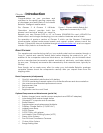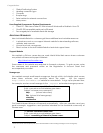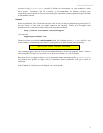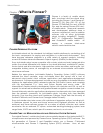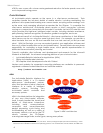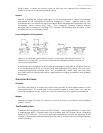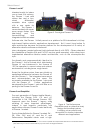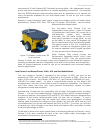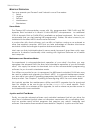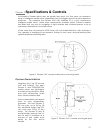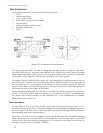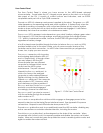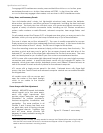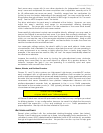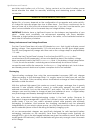
ActivMedia Robotics
performance 20 MHz Siemens 88C166-based microcontroller, with independent motor/
power and sonar-controller boards for a versatile operating environment. The controller
had two RS232-standard communications ports and an expansion bus to support the
many accessories available for your ActivMedia robot, as well as your own custom
attachments.
Sporting a more holonomic body, larger wheels and stronger motors for better indoor
performance, Pioneer 2-DX, -DXe, -DXf, and -CE models, like Pioneer 1, are two-wheel,
differential-drive mobile robots.
Figure 7. PowerBot carries over 100
k
g o
f
pay
l
oad.
The four-wheel drive Pioneer 2-AT has
independent motor drivers. Unlike its Pioneer
AT predecessor, the Pioneer 2-AT comes with a
stall-detection system and inflatable
pneumatic tires with metal wheels for much
more robust operation in rough terrain, as well
as the ability to carry nearly 30 kilograms (66
lbs) of payload and climb a 60-percent grade.
The newest version of the 2-AT, introduced in
mid-2001, includes an integrated joystick port
for manual operation and a hinged top-plate
for easy access to the internal systems.
Other Pioneer 2-like robots include the
Performance PeopleBot robots, which were
introduced in 2000. They are architecturally
Pioneer 2 robots, but with stronger motors and integrated human-interaction features,
including a pedestal extension, integrated voice and sound synthesis and recognition—
ideal for human-interaction studies as well as for commercial and consumer mobile-
robotics applications.
New Pioneer 3 and Recent Pioneer 2-DX8, -AT8, and Plus Mobile Robots
Two new models of Pioneer 2 appeared in the Summer of 2002, two more at the
beginning of 2003, and the Pioneer 3 debuted in the Summer of 2003. They are the
topics of this manual: the Pioneer 3-DX and –AT, and Pioneer 2-DX8/DX8 Plus and –
AT8/AT8 Plus mobile robots. All sport a microcontroller based on the Hitachi H8S
microprocessor, with new control systems and I/O expansion capabilities. The Pioneer 3
and 2-Plus robots also have new, more powerful motor/power systems for better
navigational control and payload.
5
Software-wise, Pioneers all are compatible with all other ActivMedia robots, including
Pioneer 1. The new ActivMedia Robotics Operating System (AROS) software extends—
but does not replace—the original PSOS and P2OS. This means that even programs that
interface at the lowest communication levels will work with all Pioneer 1, 2, and 3
platforms. This also means that the higher level clients and applications, including
Saphira, ARIA, and others including your own software, will work with AROS and any host
ActivMedia robot just as they had worked with PSOS or P2OS.
6
Of course, you will have
to extend your client software, as we have done with Saphira, ARIA, and others, in order
to take full advantage of AROS.
To the relief of those who have invested years in developing software for Pioneer 1 and 2,
Pioneer 3 truly does combine the best of the new mobile robot technologies with
ActivMedia’s tried-and-true robot architecture.
5
The interim Pioneer 2-DXf had the same, more-powerful motors as the DX8s and AT8 Plus.
6
The two-time gold medal winners of the International RoboCup robot soccer competition used Pioneer 1s one
year and quickly converted to Pioneer 2s in the next year.
9



